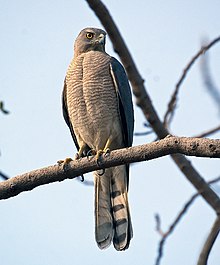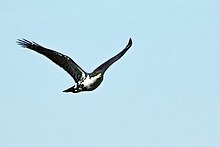Hawks and sparrowhawks
| Hawks and sparrowhawks | ||||||||||
|---|---|---|---|---|---|---|---|---|---|---|

Goshawk ( Accipiter gentilis ) |
||||||||||
| Systematics | ||||||||||
|
||||||||||
| Scientific name | ||||||||||
| Accipiter | ||||||||||
| Brisson , 1760 |
Hawks and sparrowhawks ( Accipiter ) are a genus of birds within the family of hawks (Accipitridae). It comprises around 50 species, making it the most species-rich genus of birds of prey . The representatives of the genus are small to medium-sized, have relatively short, round wings and a comparatively long tail. The genus is distributed almost worldwide, it is only absent in Antarctica and on some islands. All species are tied to wooded habitats. Many species are specialized bird hunters; in other species the food spectrum also includes other small vertebrates and insects.
description
Hawks and sparrowhawks are small to medium-sized birds of prey. The body is slender, the wings are relatively short and rounded in all species, the tail is very long. The legs and toes are very long and often extremely graceful in the smaller species.
In all species, females are significantly larger than males (reverse sex dimorphism ), the dimensions overlap at most slightly. In some of the pure bird hunters, this reverse sex dimorphism is most pronounced among all birds of prey. In the smallest species, such as the Thumbnail sparrow ( Accipiter superciliosus ), the males with a body length of 20 cm and a weight of 61.5 g are about the size of a song thrush , the largest species is the goshawk ( Accipiter gentilis ), in which the females are even larger than a common buzzard with a body length of up to 63 cm and a weight of up to 2.2 kg .
In almost all species, the upper side is monochrome, very dark gray or blackish, and the underside, in sharp contrast to this, is very light and often finely cross-banded (technical jargon: pitted). Tropical species in particular are often very colorful due to their reddish tint on the underside and neck. The wings and control springs are usually banded in dark colors. Young birds are generally much less conspicuously colored and mostly brownish on top and lighter brownish on the underside with dark dashed lines.
The typical proportions are also clearly recognizable in flight, almost all species also have a typical flight style with a few quick wing beats and a subsequent short glide phase. Seated hawks and sparrowhawks show a very upright posture, which often allows at least the identification of the genus at a greater distance.
distribution and habitat
The genus is represented on all continents (except Antarctica), most species live in the tropics . Due to its connection to the forest, the genus does not penetrate as far north as representatives of the species of birds of prey Haliaeetus , Circus or Falco . The Accipiter reach their greatest biodiversity in Southeast Asia and Oceania , where numerous species are endemic to individual islands or archipelagos . All species show a close connection to forests or at least densely wooded habitats.
There are only three species in Europe, two of them in Central Europe: the goshawk ( Accipiter gentilis ) and the sparrowhawk ( Accipiter nisus ). The Kurzfangsperber ( Accipiter brevipes ) colonizes Southeast and Eastern Europe as well as Western Asia.
Systematics
According to molecular genetic studies, the Accipiter form the sister group of the harriers within the Accipitridae .
The number of recent species of the genus Accipiter is given differently depending on the author. Ferguson-Lees and Christie gave 47 species in 2001, but thought up to 54 are likely. This makes the genus Accipiter the most species-rich of all birds of prey. A molecular genetic investigation that covers all or at least most of the species is still pending. The list of 50 species shown here follows Avibase.
- Magpie goshawk ( Accipiter albogularis )
- Schikrasperber ( Accipiter badius )
- Bicolor sparrow ( Accipiter bicolor )
- Dreifarbensperber ( Accipiter brachyurus )
- Kurzfangsperber ( Accipiter brevipes )
- Nicobar sparrow ( Accipiter butleri )
- Red- flanked goshawk ( Accipiter castanilius )
- Chiles Boar ( Accipiter chilensis )
- White-breasted sparrow ( Accipiter chionogaster )
- Sydney's spider ( Accipiter cirrocephalus )
- Collared Cattle ( Accipiter collaris )
- 'S Hawk ( Accipiter cooperii )
- Red-necked sparrow ( Accipiter erythrauchen )
- Redshank cattle ( Accipiter erythronemius )
- Wood sparrow ( Accipiter erythropus )
- Banded goshawk ( Accipiter fasciatus )
-
Lizard Hawk ( Accipiter francesiae )
- Anjouan's Sparrowhawk ( Accipiter francesiae pusillus )
- Goshawk ( Accipiter gentilis )
- Gray-headed goshawk ( Accipiter griseiceps )
- Trillersperber ( Accipiter gularis )
- Gundlachsperber ( Accipiter gundlachi )
- White-bellied goshawk ( Accipiter haplochrous )
- Halmaherahabicht ( Accipiter henicogrammus )
- Madagascar goshawk ( Accipiter henstii )
- Trughabicht ( Accipiter imitator )
- Rabble hawk ( Accipiter luteoschistaceus )
- Madagascar sparrow ( Accipiter madagascariensis )
- Black- mantled goshawk ( Accipiter melanochlamys )
- Goshawk ( Accipiter melanoleucus )
- Meyer goshawk ( Accipiter meyerianus )
- Dwarf Sperber ( Accipiter minullus )
- Archboldsperber ( Accipiter nanus )
- Sparrowhawk ( Accipiter nisus )
- White- browed goshawk ( Accipiter novaehollandiae )
- Ovambosperber ( Accipiter ovampensis )
- Ash-headed goshawk ( Accipiter poliocephalus )
- Gray abdominal Habicht ( Accipiter polio gaster )
- Prince hawk ( Accipiter princeps )
- Schlegel's cattle ( Accipiter rhodogaster )
- Fiji hawk ( Accipiter rufitorques )
- Red-bellied sparrow ( Accipiter rufiventris )
- Frog sparrow ( Accipiter soloensis )
- Eckschwanzsperber ( Accipiter striatus )
- Thumbnail sparrow ( Accipiter superciliosus )
- Afrikahabicht ( Accipiter tachiro )
- Red-breasted goshawk ( Accipiter toussenelii )
- Spot tail Sperber ( Accipiter trinotatus )
- Crested goshawk ( Accipiter trivirgatus )
- Andean sparrow ( Accipiter ventralis )
- Besrasperber ( Accipiter virgatus )
Way of hunting and food
Goshawks and sparrowhawks hunt their prey mainly from the ground-level flight or from the hide in a short, fast pursuit flight in the ground-level airspace, but also in all layers of vegetation up to the treetops. Natural structures such as hedges, trees and, in the settlement area, also houses are very cleverly used for a covered approach. The animals are extremely agile when hunting.
Many species are specialized bird hunters, but a number of other species utilize a wide range of vertebrates as well as insects, with birds often making up only a small fraction of the prey. Of the three European species, the sparrowhawk ( A. nisus ) is one of the bird specialists, the goshawk ( A. gentilis ) eats not only birds, but also mammals to a large extent, and the short-catched cattle ( A. brevipes ) feeds primarily on lizards and insects only to a small extent from mammals and birds.
Reproduction
As far as is known, all species are monogamous and strictly territorial. The nest is built from twigs and branches on trees. The eggs are incubated and the young birds are looked after almost exclusively by the female, while the male feeds the female and then the family.
literature
- J. Ferguson-Lees, DA Christie: Raptors of the World. Christopher Helm, London 2001: pp. 148-181 and 516-600, ISBN 0-7136-8026-1 .
Individual evidence
- ↑ HRL Lerner, DP Mindell: Phylogeny of eagles, Old World vultures and other Accipitridae based on nuclear and mitochondrial DNA . Molecular Phylogenetics and Evolution 37; 2005: pp. 327-346
- ↑ M. Wink, H. Sauer-Gürth: Phylogenetic Relationships in Diurnal Raptors based on nucleotide sequences of mitochondrial and nuclear marker genes . In: RD Chancellor, B.-U. Meyburg (Ed.): Raptors Worldwide . Berlin, Budapest, 2004: pp. 483–498.
- ^ The genus Accipiter on Avibase, accessed November 14, 2008
Web links
- Integrated Taxonomic Information System Accipiter Brisson, 1760



